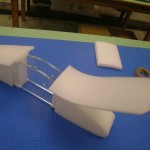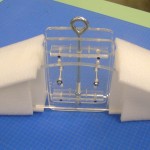
There are many factors to consider when housing very large collection objects. This was particularly true in the case of the deep sea diving suit worn by Cuba Gooding Jr. in the movie Men of Honor, which came into the care of the Ransom Center when Robert De Niro donated his archive to the Center in 2006.
The mandate was to create a storage device to increase the longevity and preserve the construction of the suit. The dive suit was too large and too heavy for housing in conventional preservation boxes, and flat storage could not have properly supported the suit’s own material from crushing itself.
The amount of storage space had to be considered, along with the construction of the support device, so the suit could be easily transported and exhibited. This dictated that the type of materials used to construct the device be archival and light weight, such as acrylic sheet and polyethylene foam.
The solution was a hanger designed to be simple, adjustable, and adaptable. The main body and structure of the hanger is 1.25 cm thick acrylic sheet. It was measured to fit the exact shape of the interior of the deep sea diving suit across the shoulders and into the arms.
The acrylic sheet panels were cut, drilled, and polished, then bolted together with two thick polyethylene foam planks placed between them. The Ethafoam serves as lightweight, highly compact archival filler. It also provides a porous surface to which layers of Ethafoam padding can be hot-glued to cover the surfaces and edges of the acrylic sheet and the bolt heads.
The central neck panel is also constructed from acrylic sheet, and screwed together to form an adjustable sliding block that is removable. This allows the shoulder support to be placed inside the suit without obstruction and refitted once the suit is ready to hang. The neck panel also has an adjustable swiveling eyebolt that provides easy attachment when transporting, hanging, and exhibiting.
The Ethafoam padding goes well beyond the shoulder seams of the suit and gives support across the entire upper half of the shoulders and well into the arms to reduce weight pulling on the shoulder seams of the suit. The width of the hanger from front to back completely supports the neck’s thick vulcanized collar, as well.
The hanger can readily be taken apart and modified for future adjustments or additions. One possibility being considered is the addition of fabric straps from the main body of the hanger to the interior of the waist for further support.
The hanger is unobtrusive in appearance but can also be covered easily for exhibition purposes. It is, of course, important that the stabilizing support that extends from the wall be securely mounted to ensure adequate support to the weight of the suit.
This article originally appeared in the January 2012 issue of the Western Association for Art Conservation newsletter.
Please click on the thumbnails below to view full-size images.









